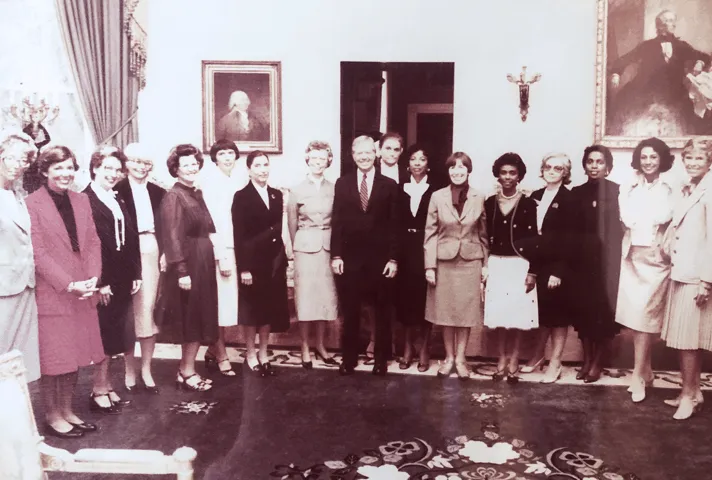Federal judges and court staff conduct a variety of public outreach efforts to improve public understanding of the Judiciary’s role in American democracy.
Fields of Dreams: Constitution Day and Citizenship Day 2019
Public understanding of the Third Branch is vital to the Judiciary’s independence. The Administrative Office of the U.S. Courts (AO) produced, conducted, and circulated several educational programs to the courts in 2019. The AO also co-sponsored, with the Second Circuit and the Annenberg Public Policy Center, the first National Conference on Civic Education and the Federal Courts, which was aimed at fostering collaboration among courts seeking to create, enhance, and expand their civics education outreach.
The AO’s courtroom-ready programs applied landmark Supreme Court cases to contemporary teen and young-adult scenarios including vaping, school walkouts, and cyberbullying. They emphasized how the law affects everyday life and the importance of civil discourse and problem-solving skills.
Another focus was on events to mark Constitution Day and Citizenship Day, which commemorates the signing of the Constitution each September. Federal judges participated in activities at major league and minor league baseball games around the country by presiding over naturalization ceremonies held at 11 baseball stadiums. Approximately 1,000 people from around the world took the U.S. citizenship oath during these events, which were captured by local television and newspaper outlets across the country. In addition, courts in 11 circuits and 25 districts celebrated the Constitution with more than 50 events on courthouse steps, at historic sites, in schools, and at other community sites.
Telling the Courts’ Story
The AO produced videos for publication on USCourts.gov and on the Judiciary’s YouTube channel that explain how the courts operate and provide other information about the federal court system. Court Shorts is a series on the concepts of separation of powers, the rule of law, and other pillars of court literacy. As part of a civil discourse initiative, the AO videotaped high school students participating in a courtroom simulation of Tinker v. Des Moines to mark the 50th anniversary of the Supreme Court’s landmark decision on students’ free speech rights.

In 1980, President Jimmy Carter met with members of the National Association of Women Judges, many of whom he had appointed to the federal bench. Second and third to Carter's left are Justice Ruth Bader Ginsburg, who joined the Court of Appeals for the District of Columbia in 1980, and Judge Mary Murphy Schroeder, appointed to the Ninth Circuit in 1979. Photo courtesy of Judge Schroeder.
A series of profiles of the women appointed as U.S. judges in 1979, a remarkable year for the expansion of gender diversity on the federal bench, was shared with several news outlets. In addition, the story of Judge Donovan Frank, of the District of Minnesota, was featured on the Judiciary’s website as part of the ongoing Pathways to the Bench series, which focuses on judges who overcame adversity to achieve success in the field of law.
Judiciary Website and PACER Improvements
A major upgrade of the Federal Court Finder feature was added to USCourts.gov in 2019, enabling users to search for any federal court by either location or court name. The upgrade was a response to public users of the website, who requested a tool with additional search options and one that is easy to use on mobile devices.
The Judiciary also made improvements to the Public Access to Court Electronic Records (PACER) service. To provide court documents at no cost for more users, the Judicial Conference raised the quarterly fee waiver for PACER subscribers from $15 to $30 per quarter, effective January 2020. (No fee will be charged unless a user incurs at least $30 in fees in a single quarter.)
Raising the threshold for paying fees will result in more than 75 percent of the system’s active users paying no fee in a given quarter in 2020. Of the remaining users who do incur fees, most are “power users,” including legal database companies that collect and aggregate massive amounts of PACER data for resale.
The PACER service provides the public with instantaneous access to virtually every document filed in every federal court. No tax dollars are expended for the operation and maintenance of PACER. Only those who use the system pay for it. There are approximately 3.1 million registered users for the PACER service, which provides access to 1 billion case documents.
Access to case information via PACER costs 10 cents per page and the cost to access a single document is capped at $3, the equivalent of 30 pages. Litigants receive a free electronic copy of each document in their case. The public has free access to case information at the courthouse, and judges’ opinions are always available for free.
The Judiciary in 2019 also created a public user group to collect advice and feedback on ways to improve electronic access to court records in the future. Members of the Electronic Public Access User Group are people who represent the legal sector, media, academia, government agencies, the public, and other entities that use PACER.
Annual Report 2019
- Annual Report 2019
- Funding/Budget
- The Courts and Congress
- The Federal Bench
- Accountability and Resource Management
- Facilities and Security
- Public Outreach
- Court Operations and Case Management
- Defender Services
- Probation and Pretrial Services
- Human Resources
- Information Systems and Cybersecurity
- Recent and Proposed Amendments to Federal Rules
- In Profile
